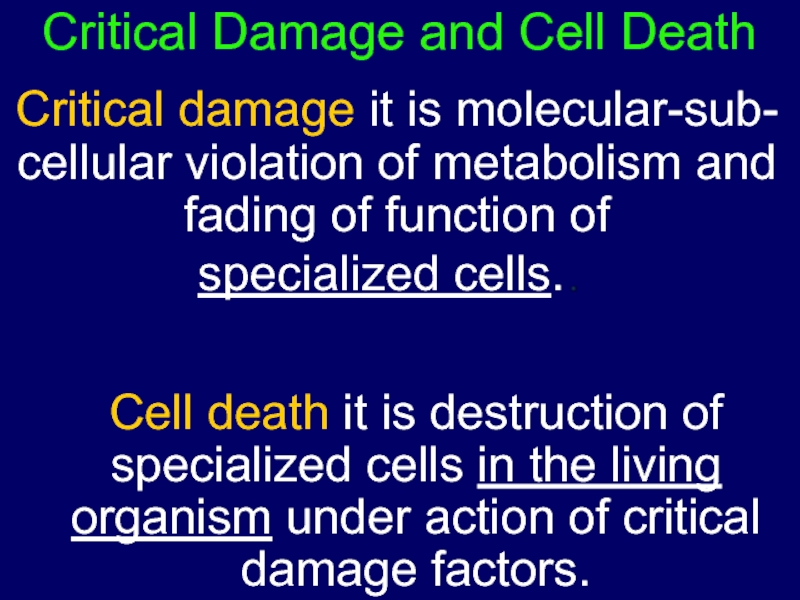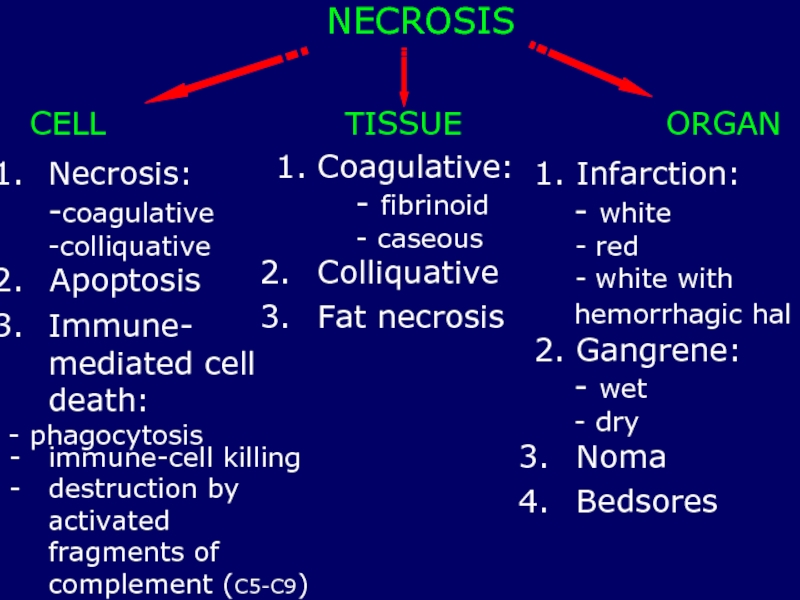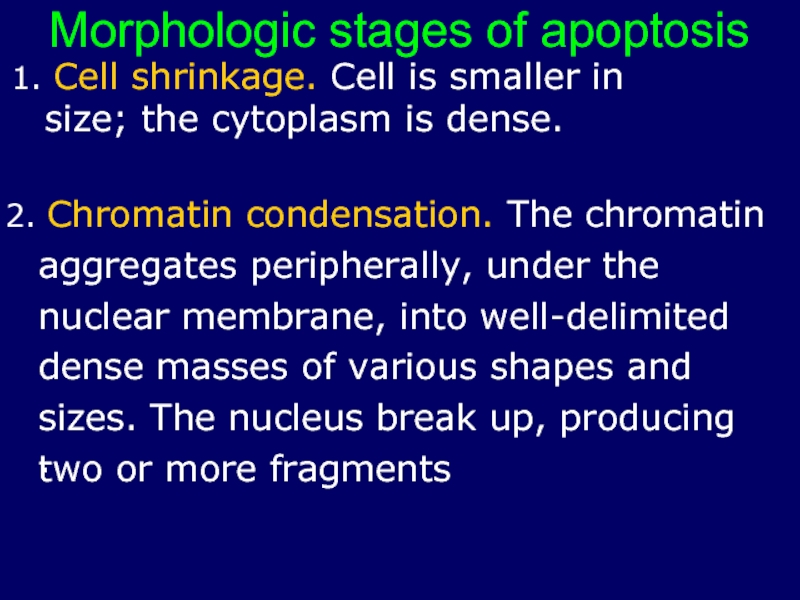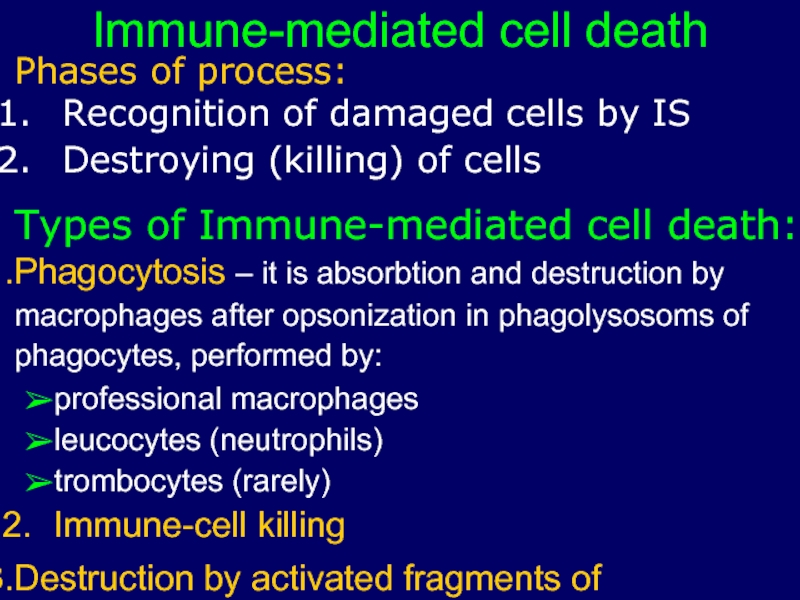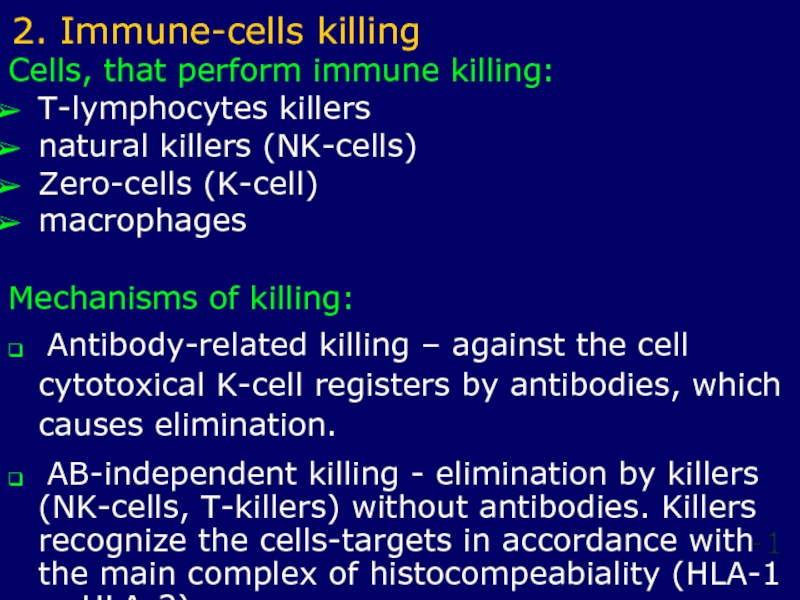- Главная
- Разное
- Дизайн
- Бизнес и предпринимательство
- Аналитика
- Образование
- Развлечения
- Красота и здоровье
- Финансы
- Государство
- Путешествия
- Спорт
- Недвижимость
- Армия
- Графика
- Культурология
- Еда и кулинария
- Лингвистика
- Английский язык
- Астрономия
- Алгебра
- Биология
- География
- Детские презентации
- Информатика
- История
- Литература
- Маркетинг
- Математика
- Медицина
- Менеджмент
- Музыка
- МХК
- Немецкий язык
- ОБЖ
- Обществознание
- Окружающий мир
- Педагогика
- Русский язык
- Технология
- Физика
- Философия
- Химия
- Шаблоны, картинки для презентаций
- Экология
- Экономика
- Юриспруденция
Critical alteration morphology of cell death necrosis of tissue and organ презентация
Содержание
- 1. Critical alteration morphology of cell death necrosis of tissue and organ
- 2. Critical Damage and Cell Death
- 4. Reasons of development:
- 6. Consequences of critical damage:
- 7. NECROSIS Necrosis - it is death of
- 8. NECROSIS CELL Necrosis: -coagulative -colliquative Apoptosis
- 10. Classification of Cells Death, based
- 11. Morphology of cell destruction:
- 12. Post-necrotic transformation of cells in living organism
- 13. Pathogenic inducted apoptosis It is a "programmed
- 15. Morphologic stages of apoptosis
- 16. Immune-mediated cell death
- 19. NECROSIS OF ORGANS It is destruction of
- 20. Reasons of development of necrosis:
- 21. CLASSIFICATION OF NECROSIS OF ORGANS I According
- 22. Clinic-morphological forms of necrosis of organs: 1.
- 23. Clinic-morphological forms of necrosis of organs: Infarction
- 24. Clinic-morphological forms of necrosis of organs:
- 25. Morphological forms of tissue necrosis:
- 26. Stages of development of necrosis: Before-necrotic changes
- 27. The outcomes of necrosis are the following: organization – the
Слайд 1
ZAPOROZHZHIAN STATE MEDICAL UNIVERSITY
The department of pathological anatomy and forensic medicine
Critical Alteration
Morphology of Cell Death
Necrosis of Tissue and Organ
Lecture on pathological anatomy for
the 3-rd year students
Слайд 2Critical Damage and Cell Death
Critical damage it is molecular-sub- cellular violation
specialized cells.
Cell death it is destruction of specialized cells in the living organism under action of critical damage factors.
Слайд 3
Critical Damage and Cell Death Objects of critical damage are structures of the
mitochondria
genetical apparatus (nuclear DNA)
plasmatic membrane
biosynthetic system
cytoskeleton
lysosomes and peroxisomes
Changes in cells can’t be determined by light microscope, it is recognized by molecular-cytochemical and autography methods.
Слайд 4Reasons of development:
Endogenous metabolic catastrophe:
bioenergetics insufficiency of cells (hypoxia of
different genesis)
damage
damage of the cells by the free radicals
increased of the ionized calcium in the cells
acid alteration of cells (pH ↓ 7)
damage of cells by the surplus of own
mediators (exayto-toxical damage)
denaturation and/or proteolysis out of control
activating of hydroxy-oxidization of lipids
Слайд 5
II. Exogenous factors of injury:
infectious aggression (viruses, bacteria, fungi's)
physical and/or chemical
Immunological damages :
а) at overloading of organism by foreign
albumen
в) iatrogenic damage (anesthetics, preparations of blood, solutions, medicines)
damage by enzymes and aggressive molecules of macrophages and leucocytes (factor of tumor necrosis, oxide of nitrogen, hydrolytical enzymes of lysosom - proteases, lipases, phosphates, hydrolyses)
Слайд 6Consequences of critical damage:
➢ partial necrosis of cell
➢ destruction of cells
➢ pathogenic induction apoptosis
➢ immune elimination of cells
➢ reparative regeneration (renewal)
➢ stimulation of neighbors
➢ development of inflammation
➢ damage of genome and appearance of new
tumor generations
Слайд 7NECROSIS
Necrosis - it is death of cells or
tissues in living organism.
Other
Autolysis – post mortem destruction of organs under action of enzymes, produced by the dead cells or bacteria.
Necrobiosis – protracted process of destruction of tissue (trophic ulcers).
Слайд 8NECROSIS
CELL
Necrosis:
-coagulative
-colliquative
Apoptosis
Immune- mediated cell
death:
- phagocytosis
TISSUE
1. Coagulative:
- fibrinoid
- caseous
Colliquative
Fat necrosis
ORGAN
1. Infarction:
- white
red
white with
hemorrhagic
2. Gangrene:
- wet
- dry
Noma
Bedsores
immune-cell killing
destruction by activated fragments of complement (C5-C9)
Слайд 9
It is the premature death and destruction of cell’s organelles in the living organism under action of critical damage factors
Phases
Critical damage
Destruction of cells and intercellular
connections:
cytokaryolysis,
coagulative necrosis
Post-necrotic transformation of cells
Duration: 1 min – 24 hours
NECROSIS of CELL
Слайд 10
Classification of Cells Death, based
on the mechanism of development:
Necrosis of specialized
Pathogenic inducted apoptosis
Selective immunological elimination of cells
Слайд 11Morphology of cell destruction:
1. Karyolysis - the basophilic of the chromatin
activation of the DNA-ses.
2. Pyknosis - characterized by nuclear shrinkage
and increased basophiles. Here the DNA
apparently condenses into a solid, shrunken
basophilic mass.
3. Karyorrhexis - the pyknotic or partially pyknotic nucleus undergoes fragmentation.
Слайд 12Post-necrotic transformation of
cells in living organism
Autolysis – destruction of cells by
Phagocytosis by macrophages
Destruction by free-radical molecules of leucocytes (at inflammation)
Destruction by ferments of bacteria (at infected injury)
Слайд 13Pathogenic inducted apoptosis
It is a "programmed by genes cell death" or
Features of apoptosis:
The process begins at activation of genes of apoptosis or inhibition of genes that can stop apoptosis
Duration of the process – 10-60min
Fragmentation of cell into apoptotic bodies at the end the process
Слайд 14
1. Cell shrinkage. Cell is smaller in size; the cytoplasm is
2. Chromatin condensation. The chromatin aggregates peripherally, under the nuclear membrane, into well-delimited dense masses of various shapes and sizes. The nucleus break up, producing two or more fragments
Morphologic stages of apoptosis
.
Слайд 15Morphologic stages of apoptosis
3. Formation of cytoplasmatical blebs and apoptotic bodies.
4. Phagocytosis of apoptotic cells or bodies by adjacent healthy cells, either parenchymal cells or macrophages.
Слайд 16Immune-mediated cell death
It is damage of cells by immunocytes and auto-
By this method can be destroyed:
Tumor cells
Transplanted cells
Infected cells
Normal cells (at autoimmune disease)
It is performed by:
immunocytes
activated fragments of complement (AB)
Слайд 17
Phases of process:
Recognition of damaged cells by IS
Destroying (killing) of cells
Types
Phagocytosis – it is absorbtion and destruction by
macrophages after opsonization in phagolysosoms of phagocytes, performed by:
➢professional macrophages
➢leucocytes (neutrophils)
➢trombocytes (rarely)
Immune-cell killing
Destruction by activated fragments of complement (C5-C9)
Immune-mediated cell death
Слайд 18
Cells, that perform immune killing:
T-lymphocytes killers
natural killers (NK-cells)
Zero-cells (K-cell)
macrophages
Mechanisms of killing:
❑ Antibody-related
❑ AB-independent killing - elimination by killers (NK-cells, T-killers) without antibodies. Killers recognize the cells-targets in accordance with the main complex of histocompeabiality (HLA-1 or HLA-2).
2. Immune-cells killing
Слайд 19NECROSIS OF ORGANS
It is destruction of all
components of organs (specialized cells,
nerves) in the living organism
under action of critical
alteration.
Слайд 20Reasons of development of necrosis:
➢protracted ischemia
➢stopping of arterial blood supplying
➢damage by the
chemical factors
➢inflammatory-destructive action of
infects – bacteria, fungi, viruses
➢massive damage of organ by
endogenous metabolites
Слайд 21CLASSIFICATION OF NECROSIS OF ORGANS
I According to morphology:
Dry necrosis (coagulative) –
caseouse – at syphilis, leprosis, tuberculosis
fibrinouse – in vessel’s walls at hypertonic disease
Wet necrosis (colliquative) – lysis, hydrolysis of soft tissue
Fermented necrosis of fat tissue (fat necrosis) – destruction o fat tissue by ferments of pancreas
II According to spreading:
partial necrosis of specialized cells
total necrosis
selective hearth necrosis of specialized cells
III According to clinic-morphological picture:
gangrene
infarction (heart attack)
noma
bedsores
Слайд 22Clinic-morphological forms of necrosis of organs:
1. Gangrene – total necrosis of
а) dry – at the thrombosis of arteries, an organ acquires the black coloring
moist (wet) – at the thrombosis of arteries and veins + influencing of putrid bacteria
gas (anaerobic) – necrotic tissue is infected by Cl.perfingens
Слайд 23Clinic-morphological forms of necrosis of organs:
Infarction – localized necrosis of part
а) white (ischemic)
red (hemorrhagic)
white with hemorrhagic halo
Слайд 24Clinic-morphological forms of necrosis of organs:
Bedsores – necrosis of soft tissue
Noma – widespread necrosis of soft tissue under influence of bacterias (Bacterium fusiformis, spirocheta dentinum) or fungies at immune insufiency.
Слайд 25Morphological forms of tissue necrosis:
Coagulative necrosis
Liquefactive necrosis
Caseous necrosis
Fat necrosis
Слайд 26Stages of development of necrosis:
Before-necrotic changes – from the beginning of
Stage of necrosis – destruction of components and structures of organ with formation of biological demarcation of dead tissue (it takes a few days).
Microscopically: kariocytolysis, coagulative necrosis of cell, destruction of vessels.
Clinic: functional insufficiency of organ, fever,
leykocytosis.
The Postnecrotic changes – reparative regeneration (remodulation) with complete or not full regeneration of organ structures.
Слайд 27The outcomes of necrosis are the following:
organization – the replacement of necrotic tissues by
connective
incapsulation – formation of connective tissue
capsula around necrotic area
petrification – accumulation of calcium salts in the area of necrosis
cyst formation
hyaline change – the accumulation of hyaline masses
in the area of necrosis
sequestration – the formation of sequestrum
ossification – the appearance of bone tissue in the area of necrosis
regeneration – the restoration of necrotic tissues
purulent fusion of necrotic tissues
mutilation – spontaneous tearing away of the
necrotic tissues
autolysis

